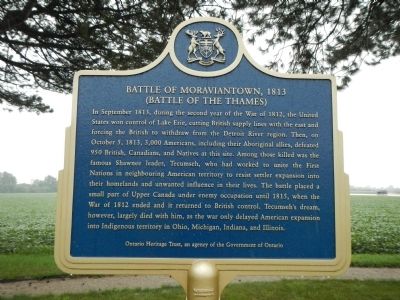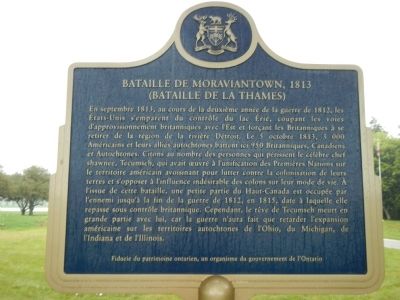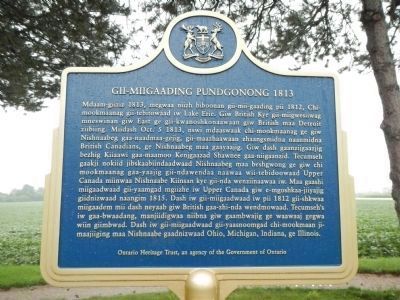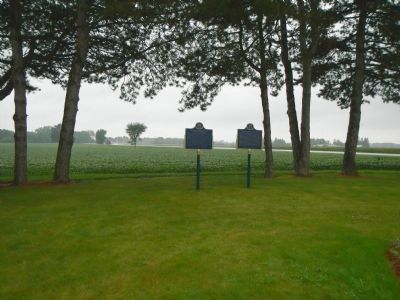Thamesville in Chatham-Kent, Ontario — Central Canada (North America)
Battle of Moraviantown, 1813
Bataille de Moraviantown, 1813
— (Battle of the Thames) / (Bataille de la Thames) —
Inscription.
French
Erected by Ontario Heritage Trust.
Topics. This historical marker is listed in these topic lists: Native Americans • War of 1812. A significant historical month for this entry is September 1813.
Location. 42° 33.931′ N, 81° 55.858′ W. Marker is in Thamesville, Ontario, in Chatham-Kent. Marker is on Longwoods Road (County Route 2), on the right when traveling east. Touch for map. Marker is at or near this postal address: 14376 Longwoods Road, Thamesville ON N0P 2K0, Canada. Touch for directions.
Other nearby markers. At least 8 other markers are within walking distance
of this marker. Tecumseh (within shouting distance of this marker); Prelude to Battle (within shouting distance of this marker); Why Choose This Site? (within shouting distance of this marker); Participants in the Battle of the Thames (about 90 meters away, measured in a direct line); a different marker also named Participants in the Battle of the Thames (about 90 meters away); a different marker also named Participants in the Battle of the Thames (about 90 meters away); a different marker also named Participants in the Battle of the Thames (about 120 meters away); a different marker also named Participants in the Battle of the Thames (about 120 meters away). Touch for a list and map of all markers in Thamesville.
More about this marker. These markers are located on unnamed side road leading south along with other markers relating to the Battle of the Thames.
Regarding Battle of Moraviantown, 1813. The Battle of the Thames (sometimes called the Battle of Moraviantown) occurred 5 October 1813, during the War of 1812. Following the American naval victory under Captain Oliver H. Perry in the Battle of Lake Erie at Put-in-Bay on 10 September 1813, the entire western peninsula of Upper Canada was in danger of falling into enemy hands. Major General
Henry Procter, who commanded all British and Canadian forces west of Burlington, was short of supplies and decided to retreat up the River Thames. (Submitted on October 29, 2014, by Barry Swackhamer of Brentwood, California.)
Related markers. Click here for a list of markers that are related to this marker. To better understand the relationship, study each marker in the order shown.
Also see . . . Battle of the Thames (Moraviantown). "The Canadian Encyclopedia" entry (Submitted on July 27, 2020, by Larry Gertner of New York, New York.)
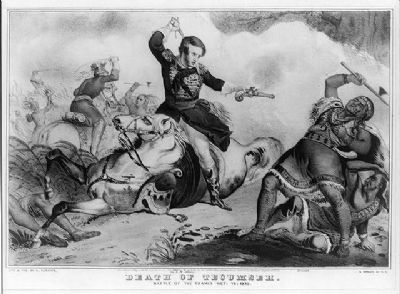
Photographed By Currier and Ives, 1846
5. The Death of Tecumseh
Print shows Col. R.M. Johnson using a pistol to kill Tecumseh during the War of 1812, at the battle of the Thames in Ontario, Canada.
When Johnson later ran for political office, his campaign slogan ran:
"Rumsey-dumsey,
Rumsey-dumsey,
Colonel Johnson
Killed Tecumseh."
When Johnson later ran for political office, his campaign slogan ran:
"Rumsey-dumsey,
Rumsey-dumsey,
Colonel Johnson
Killed Tecumseh."
Credits. This page was last revised on July 28, 2020. It was originally submitted on October 29, 2014, by Barry Swackhamer of Brentwood, California. This page has been viewed 1,050 times since then and 27 times this year. Photos: 1, 2, 3, 4, 5. submitted on October 29, 2014, by Barry Swackhamer of Brentwood, California. • Andrew Ruppenstein was the editor who published this page.
